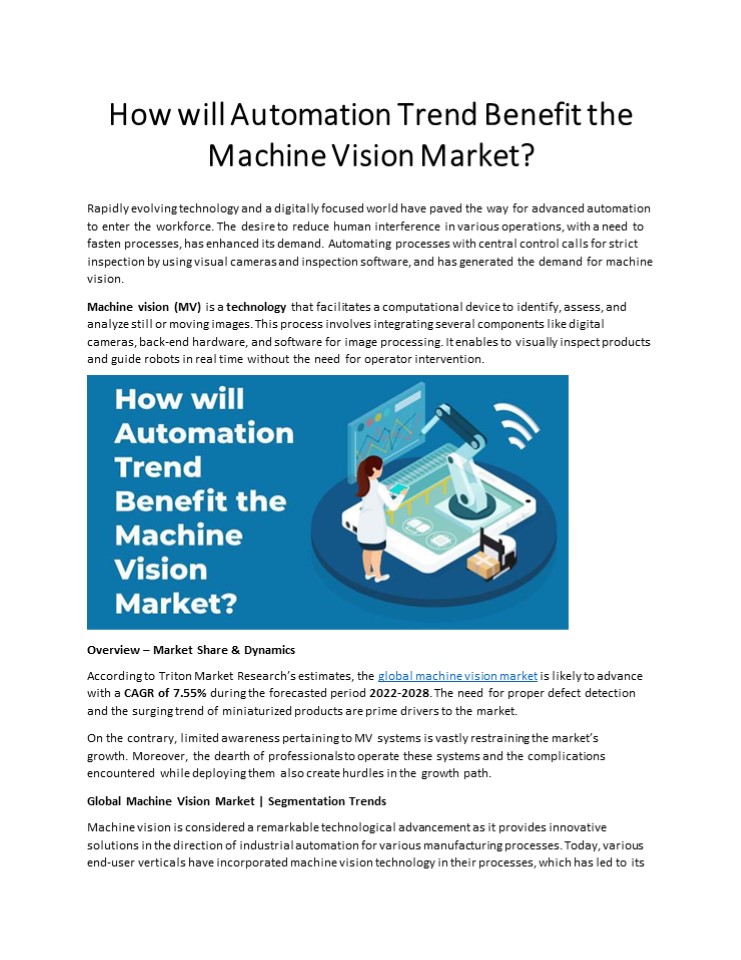How will Automation Trend Benefit the Machine Vision Market? - PowerPoint PPT Presentation
Title:
How will Automation Trend Benefit the Machine Vision Market?
Description:
The Machine Vision Market blog provides the latest news, research, and insights on machine vision technology. Learn about new machine vision systems and applications, software updates, and market findings. – PowerPoint PPT presentation
Number of Views:1
Title: How will Automation Trend Benefit the Machine Vision Market?
1
How will Automation Trend Benefit the Machine
Vision Market?
Rapidly evolving technology and a digitally
focused world have paved the way for advanced
automation to enter the workforce. The desire to
reduce human interference in various operations,
with a need to fasten processes, has enhanced its
demand. Automating processes with central control
calls for strict inspection by using visual
cameras and inspection software, and has
generated the demand for machine vision. Machine
vision (MV) is a technology that facilitates a
computational device to identify, assess, and
analyze still or moving images. This process
involves integrating several components like
digital cameras, back-end hardware, and software
for image processing. It enables to visually
inspect products and guide robots in real time
without the need for operator intervention.
Overview Market Share Dynamics According to
Triton Market Researchs estimates, the global
machine vision market is likely to advance with a
CAGR of 7.55 during the forecasted period
2022-2028. The need for proper defect detection
and the surging trend of miniaturized products
are prime drivers to the market. On the contrary,
limited awareness pertaining to MV systems is
vastly restraining the markets growth. Moreover,
the dearth of professionals to operate these
systems and the complications encountered while
deploying them also create hurdles in the growth
path. Global Machine Vision Market Segmentation
Trends Machine vision is considered a remarkable
technological advancement as it provides
innovative solutions in the direction of
industrial automation for various manufacturing
processes. Today, various end-user verticals have
incorporated machine vision technology in their
processes, which has led to its
2
- increased demand. In addition, rapid development
is seen in MV technology. Thus, newer types of
imaging systems are available today, with robust
components, and are used for a range of purposes,
thereby creating greater benefits for the users. - Check out key Segmentation Trends that Shape the
Market - Machine vision sees huge potential in the
healthcare vertical. Quality control is very
important in the field of healthcare-related
manufacturing, and the implementation of MV
systems plays a major role in achieving the
highest accuracy. In February 2018, Dubai
strengthened its position as a global leader in
medical technology, by launching the Mobilis
(MOdern BIonic LImb Solutions) smart factory. The
plant facilitates advanced manufacturing
processes like IoT, cloud computing, and robotics
to produce prosthetic and orthotic devices. - 3D machine vision systems perform multiple
inspections and are equipped with advanced
cameras, sensors, processors, and illuminators.
3D type systems are the most dynamically
performing MV systems. One of the most eminent
and widely used 3D imaging products is the
Microsoft Kinect for the gaming console Xbox 360,
which uses the structured light principle for
calculating depth. Other common 3D imaging
techniques include stereo vision, laser
triangulation, interferometry, and time of flight
(TOF). - Camera is a vital hardware component that plays
an important role of capturing images. The
segment is driven primarily by smart cameras.
Smart camera-based machine vision systems are in
high demand due to their advanced technology,
ease of installation, low cost, and user-
friendliness. With rapid adoption, this equipment
is slowly capturing the market. In June 2021,
Teledyne FLIR launched A500f and A700f smart
sensor-based cameras. They offer high-
temperature detection and condition monitoring
for extreme environments and are paired with
on-camera analytics and alarm capabilities. - Inspection is one of the prime applications of MV
systems and is crucial for assuring product
quality. Inspecting products helps detect
functional flaws, contaminants, and other
defects. Some examples include inspecting
displays to confirm pixel presence or verifying
icons, assessing medicine tablets for flaws, or
monitoring touch screens to measure backlight
contrast levels. In August 2021, OMRON
Corporation introduced the PCB inspection system
as a part of its VT-S10 Series. It is enabled
with AI to automate the inspection process with
high-precision and features an industry-first
imaging technique, eliminating the need for
specialist skills. - Future Scope - Smart Manufacturing
- In this global race towards greater automation,
machine vision is not only being used in
traditional industrial sectors, but is also
conquering brand new areas. Several organizations
are using these advanced systems in a bid to
reduce manufacturing cost time, enhance
flexibility, gain better process control, and
easily oversee daily processes. This is
facilitating the shift towards upgradation to
completely automated smart factories to stay
ahead of intense competition. - Additionally, with high market attractiveness,
numerous global players have begun investing
heavily in the machine vision market. They are
also engaging in research and development
activities to make their
3
systems more efficient and cost-effective. The
adoption of automation by the manufacturing
sector has thus led to a technological
renaissance, thereby propelling the growth of the
machine vision market. FAQs Q 1) What are the
different types of machine vision systems? 1D,
2D, and 3D are the different types of machine
vision systems used. Q 2) Which are the different
verticals in which MV systems are
used? Automotive, electronics semiconductors,
healthcare, food packaging, and other
industries are the key areas where machine vision
systems are being adopted.































